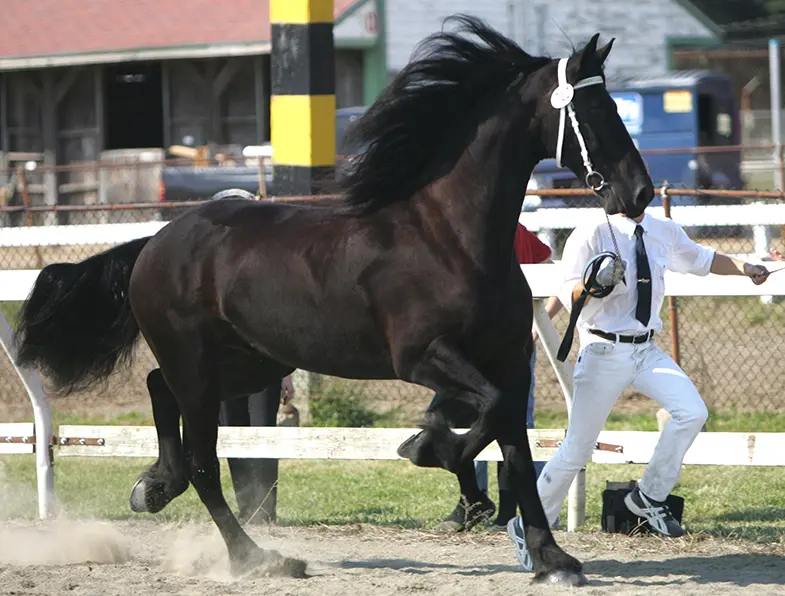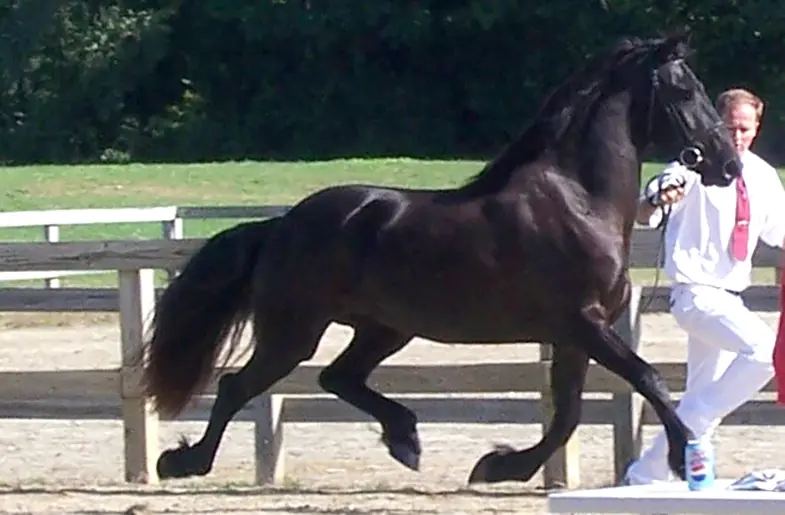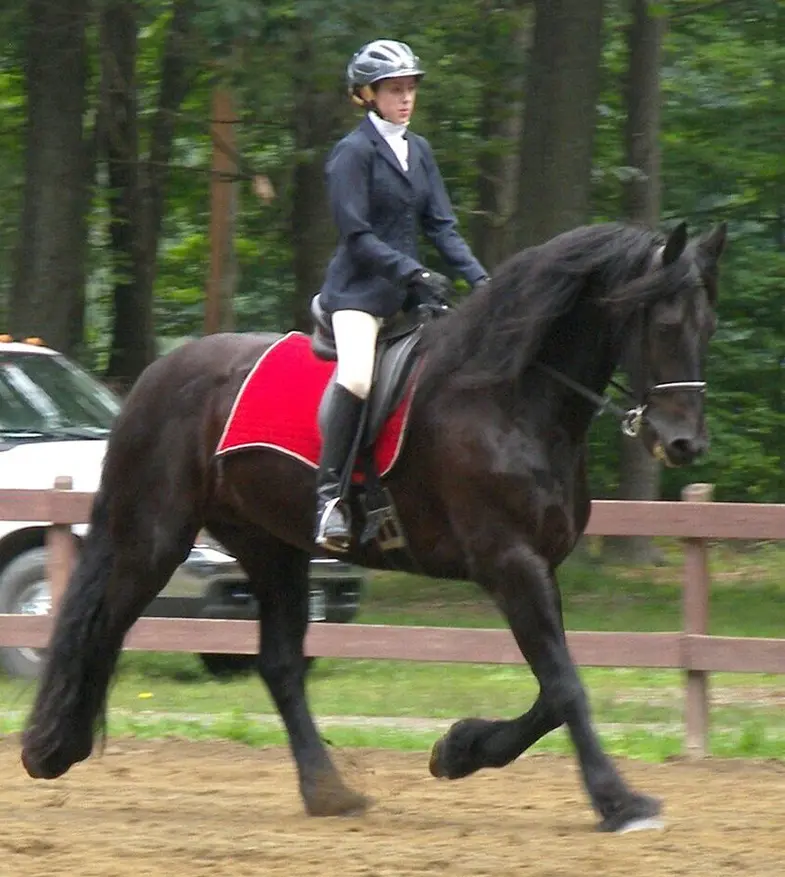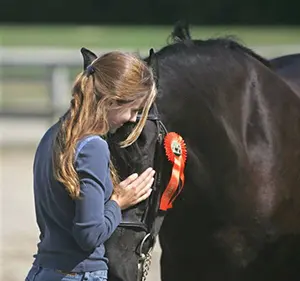There’s no question that Friesian horses have a ‘wow’ factor. Their conformation, stunning looks, and presence are unmatched. It is no surprise that Friesians are a go-to for cinema, parades, and performances. The Friesian horse is known for its friendliness, magnificent presence, natural beauty, calm demeanor, intelligence, adaptability, and work ethic.
This incredible breed has stolen the hearts of many. Are you ready to find out why?
Height: Friesians range in height from 15hh (60 inches) up to 17hh (68 inches). Friesians must be at least 15.1 ¼hh (61 inches) tall at 3 years of age to be registered in the studbook.
Color: Friesian horses must have a black coat in order to be registered in the Dutch studbook. They are allowed to have a small white star on their foreheads. There are also some pure-bred chestnut Friesian, but these horses are a result of the ‘chestnut factor’ and are not registerable.
Personality: Friesians are known for their calm demeanor. They are quick learners and very eager to please. This is one of the many reasons why the Friesians is such a versatile breed.
Country of Origin: Friesland
Registry: There are two primary registries for Friesian Horses: KFPS and FPZV. The United States branch of the KFPS is the Friesian Horse Association of North America.
Friesians Originated in Friesland
Friesians originated in Friesland, one of the twelve provinces of the Kingdom of The Netherlands in northwest Europe around 500 BC. Friesians are the only known surviving native breed from this area, which is now known as the Netherlands.
Friesians Have Heavily Influenced Other Breeds
The Friesian has played a significant role in the development of many breeds. Breeds such as Oldenburgers, Orlov Trotters, Norfolk Trotters, Shires, and some ponies, like the Fell and Dales ponies, all have the influence of Friesian bloodlines.
Many horse owners and breeds also believe Morgan horses have Friesian bloodline ties, but we cannot find any documentation to prove this. However, there are so many similar traits (such as high, arching necks, upward build, and sharply angled shoulders to name a few) that it is not hard to believe this theory.
Friesians Have Become Lighter over the Years
Friesians were once a much heavier breed, designed to carry knights in full armor. When Friesians were no longer being used in battle, Andalusian and Arabian bloodlines were introduced to lighten the breed. This made it more suitable for pulling carriages and for riding schools for dressage in France and Spain.
Friesians Were War Horses
Friesians were a favored breed in battle throughout history. We have Roman historical records of Friesian cavalries as early as 150 AD! There are many illustrations of historic battles showing horses with significant similarities to Friesians. One of the first recordings that specifically mentions a Friesian horse was in 1544 when a German official rode a Friesian to the Reichstag in Spiers.
Friesians Almost Went Extinct – Multiple Times!
Friesian horses almost went extinct numerous times for different reasons during the end of the 19th century. In 1913, there were only three breeding stallions left in the world! With the introduction of heavier, more practical breeds, farmers shifted away from the Friesian in favor of breeds more suited to grueling work in the fields.
Thankfully, the Friesian was kept alive through careful breeding programs established by a small group of people with a love for this amazing breed. The breed is fortunate to have attracted passionate people throughout history that were willing to preserve the breed into what we know today.
Friesians Came to the US Twice
The first record of a Friesian being imported to the United States was in 1625, but the bloodlines were soon lost across North America due to crossbreeding. In 1974, the breed was again introduced into the United States by a gentleman from Ohio.
Luckily, the second introduction was a hit and the breed grew in popularity enough to warrant a national breed association and show in the United States by 1983.
Friesians Participate in Keurings
Friesians participate in keurings as part of their registration process. Keuring is the Dutch word for inspection. These keurings are designed to ensure approved breeding stallions are producing quality offspring. Horses are judged on their conformation and movement in-hand at the walk and trot. The judges at Keurings are certified in the Netherlands to judge the Friesians against a specific standard.
Generally, Friesians are taken to an official keuring as foals and three-year-olds. However, you can take yearlings, two-year-olds, and adults for further judging if desired. The score at each keur is added to the horse’s official registration papers.
Friesians Are Very Popular in Film
The elegant presence of the Friesian horse is captivating in person and eventually caught the attention of Hollywood. Friesians are now an incredibly popular breed in films. The stunning jet-black coat, flowing mane and tail, long feathers, and high knee action create a beautiful visual on camera.
Some of the most notable movies/series featuring Friesians include The Mask of Zorro, Sense and Sensibility, Alexander, Game of Thrones, and The Chronicles of Narnia. There have also been a few used in the latest Netflix release of Bridgerton!
Friesians Are Versatile
While Friesians have their roots as war horses and carriage horses, this breed is quite versatile. Friesians are used for dressage, driving, trail riding, parades, and other events. We have several friends who ride their Friesians in hunt seat and western!
Crossbreeding Is a No-No
This is a bit of a controversial topic in the Friesian world, but the KFPS does not allow crossbreeding. The reason—Friesians almost went extinct several times due to crossbreeding and they do not want to lose the breed.
Crossbreeding a KFPS registered Friesian can result in the registration papers being pulled for that horse. While this may seem restrictive (and many people believe it is), the registry is attempting to preserve the breed we all love.
You can’t breed to any stallion
Friesian stallions undergo an extensive approval process before they are approved for breeding, under the KFPS rules. Once a stallion completes this approval process, they are given provisional approval. This stallion’s offspring are then judged at the keuring to see if the stallion is adding or improving the breed. If the offspring are of excellent quality, according to the breed standard, the stallion is given permanent breeding approval.
Related questions
Are Friesians good for beginners?
Friesians are known for having a calm, forgiving temperament. While this temperament is ideal for beginners or someone returning to horses after a long break, their movement can be intimidating. Friesians have ‘large gaits’ , meaning they have a lot of action in their knees, shoulders, and hind legs, unlike breeds such as the Quarter Horse and Paint Horse.
If you are not used to this type of movement, it may take a little getting used to. That being said, Friesians adore children. We grew up around Friesians and their puppy dog personalities.
How much do Friesians cost?
Friesian horses can range anywhere from $8,000 for a foal to $100,000+ for a well-trained, well-papered adult. Similar to other breeds, the cost of a Friesian will depend on their bloodlines and training. Friesians have an additional area that can increase their value; a keur score.
About Ashton
I’ve been around horses my entire life, but my Friesian journey started just over 20 years ago. Our horses have always been a part of our family. They have traveled with us as we relocated from Vermont to New York to Iowa and finally, to Arizona.
Ashton Kirkeide runs Starlit Ridge Friesians and you can check out their site here.
I hope you found this article helpful. If you did I’d be grateful if you could share it please as it would really help me.
Recommended products
Over the years I have tried hundreds of different horsey products, from various blankets and halters to different treats. Some I’ve loved, others I’ve hated but I thought I’d share with you my top all-time favorite products, the ones I never leave the yard without. I’ve included links to the products (which are in no particular order) that I really think are great.
- Horse Knots by Reference Ready – If you’re like me and enjoy pocket reference guides then you’ll love this knot tying guide. These handy cards can easily fit in your pocket or attach to the saddle for quick reference. They’re waterproof, durable and are color coded to make them easy to follow.
- Mane ’n Tail Detangler – Even if you never show your horse you’ll need to detangle his tail from time to time (and possibly his mane too) which is always a challenging chore! I’ve found that if I run a little bit of detangler through my horse’s tails every few days it stops them from getting matted up and makes combing them easy, even if they’re coated in mud. I don’t know if I should admit to this or not but it also works wonders on my hair.
- TAKEKIT Pro clippers – Over the years I’ve tried a lot of different clippers and while some were obviously better than others I found these to be by far the best. They are heavier than a lot of other clippers but for me, that’s a good thing, it makes them feel more sturdy and hardwearing. On top of that they have a range of speeds so are just as good for clipping your horse’s back as they are his face. I also like the fact that they come in a handy carry case but that’s not for everybody. The company that makes them is super good and incredibly helpful too, a real bonus these days. The only thing I wasn’t keen on was the fact that it doesn’t come with any oil, but that’s not a major problem as it’s not difficult to buy lubricant.
- Shire’s ball feeder – There are so many boredom buster toys out there but I like to use these every day, regardless of whether or not my horses are bored. I find that it helps to encourage my horses to problem solve by rewarding them with treats (or pieces of fruit) but it also mimics their natural grazing behavior which helps to keep them calm and de-stressed.
- Horse safe mirror – This is a strange one that many people are surprised about but I like to put horse safe mirrors in the trailers as well as in the quarantine stalls. It helps to prevent the feeling of isolation by giving the impression of other horses being around. Being herd animals horses can get extremely stressed when they feel that they’re on their own but with these stick-on mirrors, they believe that at least one other horse is with them.
- Rectal thermometer – I know this isn’t glamourous at all but it’s vital for your horse’s well-being to be able to check their temperature and a rectal thermometer is the easiest way of doing this which is why I’ve added it to the list.
Shopping lists
I’ve also put together a few shopping lists of essential items that I’ve found helpful over the years. I’ve broken the lists down into different categories rather than put everything in one massive list 😉




